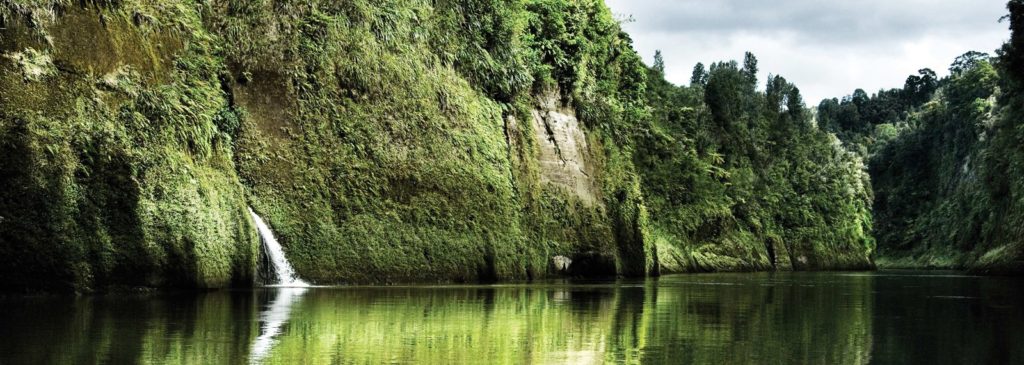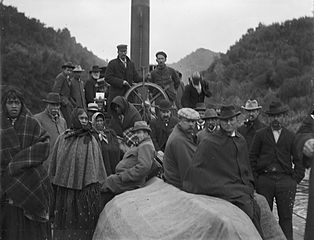New Zealand’s Whanganui River has become the first river in the world to be recognised as a living entity with the legal status of a person. New Zealanders have been joking about whether the river might now vote, buy a few beers since it’s well over the legal drinking age, or be charged with murder if a swimmer drowns!
Peter Jackson used this river as the location for ‘Mordor’ in his three ‘Lord of the Rings’ films.
On March 15th this year, New Zealand’s parliament passed a bill to allow the Whanganui River to represent its own interests and advocate on its own behalf in the sense that it can own property, incur debts and petition the courts, along with having the duties and liabilities of a legal person. (it’s true!) The new bill acknowledges the river as a “living whole”, rather than trying to carve it up, finally settling an ownership dispute that has dragged on for 140 years.
New Zealand’s attorney-general, Chris Finlayson, admitted the move was unprecedented. “I know some people will say it’s pretty strange to give a natural resource a legal personality, but it’s no stranger than family trusts, or companies, or incorporated societies,” he said. The river will be represented by two nominees, one appointed by the Maoris, and the other by the government which has established a $30 million fund to protect the river.
OTHER LEGAL RIGHTS
An area of forested hills known as Te Urewera, north-east of the river and once a national park, became a person for legal purposes in 2014. This is not unique to New Zealand. Around the world companies, foundations and assorted government agencies have legal rights and responsibilities independent of the people who staff them.
MAORI RELATIONSHIP
Maoris call the river “Te Awa Tupua” and have a deep spiritual connection to it with the saying,“I am the river and the river is me.” They have fought for recognition of this relationship since the 1850s with a legal battle that has been the longest-running litigation in New Zealand’s history. They had long been concerned about the government’s impact on the health and wellbeing of the river and always regarded it as an indivisible and living whole which includes all its physical and spiritual elements from the mountains of the central North Island to the sea. This is where native and European cultures clashed, one respecting nature, the other wanting to exploit it.
RIVER FACTS
The picturesque Whanganui River is New Zealand’s third-longest river winding about 290km (180 miles) from the Central Plateau through the bushy King Country to the ocean at Whanganui City. Despite 200 rapids, it is also the country’s longest navigable river and has long been a major route to the interior for Maoris who once lived in large numbers along the river banks. Even after the arrival of European settlers, it remained an important means of transportation.
The provincial city of Whanganui straddles the Whanganui River and four bridges span it within the city’s boundaries.
RIVER’S COMMERCIAL ATTRACTIONS
In 1892, fifty years after the arrival of the first European settlers, Thomas Cook saw an opportunity to exploit the river’s eye catching beauty so commissioned an Australian merchant, Alexander Hatrick to carry tourists on a cruise he promoted as ‘The Rhine of Maoriland’. (that title wouldn’t be PC today) Hatrick successfully developed his operation and in 1899, his narrow paddle steamer, the Waimarie, went into service.
The PS Waimarie continued to ply the river until she sank at her wharf in 1952 after half a century of service. The old ferry languished as a wreck for 40 years before a band of enthusiasts took an interest in restoring it. After six long years of restoration, the country’s only coal powered paddle steamer, the historic Waimarie is again splashing her way along the Whanganui River at a sedate six to ten knots.
The lovely old boat is now proving a popular tourist attraction in her own right. The 80 ton Victorian era steamer requires a crew of six and can carry 150 passengers in carefully restored comfort. The river is also popular with canoeists and there are a couple of commercial enterprises supplying boats for tourists to explore the special magic of this river.
NEW ZEALAND’S JERUSALEM
In the 1840s, Jerusalem was the largest settlement along the Whanganui River.
Various missionaries found their way to the isolated settlement with the Roman Catholics setting up a Maori mission in 1854 but after some priests were killed during an inter-tribe battle, the remaining clergy abandoned the place. Forty years later, the Sisters of Compassion arrived to build a convent. Shortly after this, unwanted children from around New Zealand were housed by the nuns. Mother Aubert, the driving force at the convent, became well known right across New Zealand with the potent medicines she concocted at the convent becoming prized by many European settlers of the period. The nuns also set up a school to give the abandoned children, along with local Maori children, a basic education. In 1896, the nuns opened a Foundling Home to care for new born babies. After the deaths of 7 babies, an inquest decided it was either measles or contaminated milk that killed them but with the convent unwilling to allow government officials to inspect the facilities, a question mark still hangs over the deaths.
Well known New Zealand poet James Baxter set up a commune in Jerusalem in 1970, but it was dissolved when he died two years later. He is buried there. Even today, Jerusalem is an isolated settlement little known to most New Zealanders. The convent and a church remain as a rather melancholic reminder of its religious origin and the work carried out there by a small group of dedicated nuns who must have suffered considerably in the damp, isolated settlement.
ACTION IN INDIA
Days after the New Zealand river law was passed, an Indian court declared two of the biggest and most sacred rivers in India, the Ganges and its tributary, the Yamuna, (also called Jumna) to be people too. Making explicit reference to the Whanganui River settlement, the Indian court assigned legal “parents” to protect and conserve their sacred waters. Local lawyers hope the ruling will help fight the severe pollution blighting both rivers. The rivers’ defenders will no longer have to prove that discharges into them harm anyone, since any contamination will now be a crime against the rivers themselves.
Please leave a comment. it helps to know what you think.
Ceidrik Heward

























 Visit Today : 721
Visit Today : 721 Total Visit : 1073793
Total Visit : 1073793